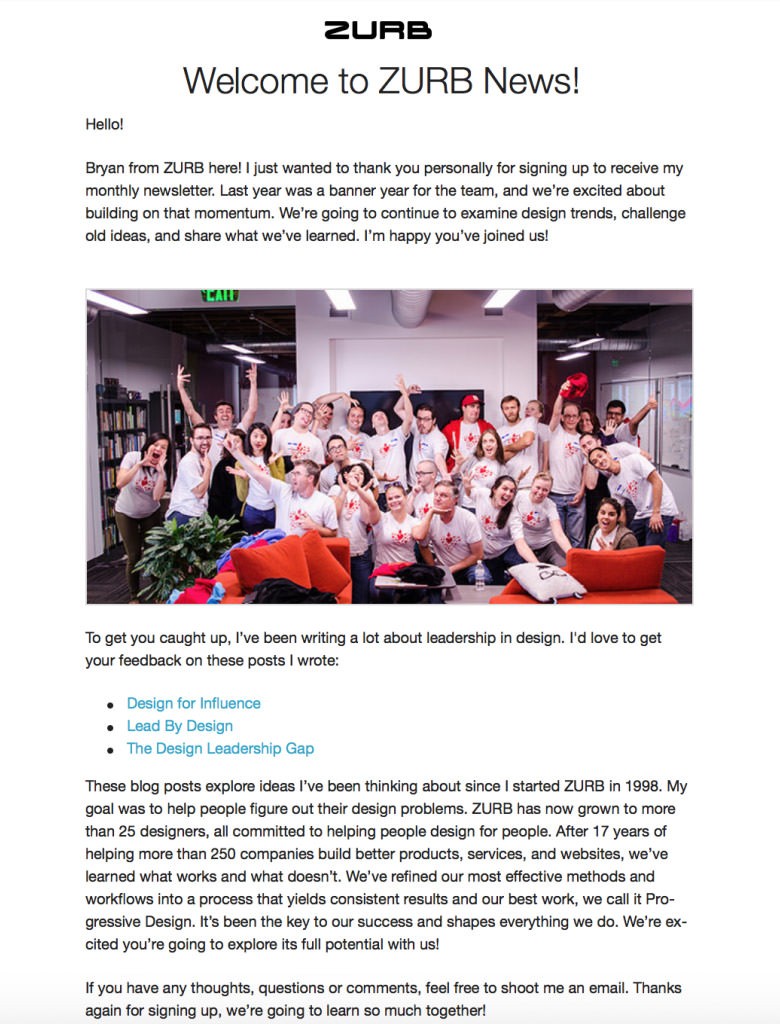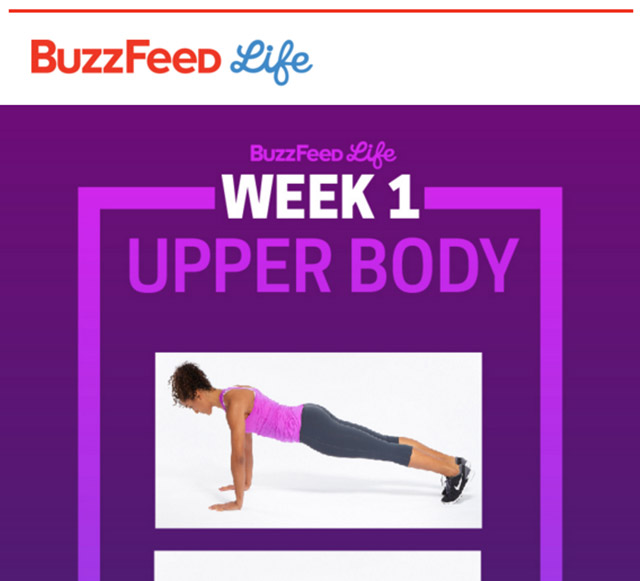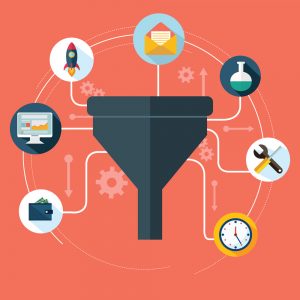Hear from VP of Customer Marketing and Insights at Michaels, Michael Cooper, on their experience with personalization and consumer expectations in an omnichannel customer experience.
2016
Discover how automation can put the “personal” back in personalization
Is your personalized marketing really that personal?
The overwhelming majority of consumers prefer personalized experiences when engaging with their favorite brands (more than 70% of consumers in the US and UK!). Personalized experiences are not only very gratifying, but they satisfy two very important, and absolutely necessary, digital age value points: the consumer need for control, and information overload prevention.
The personalization trend has picked up steam in recent years as marketers and brands now recognize the great benefits of providing consumers a personalized experience, including: faster response times, improved engagement rates, and higher conversion rates. Yet, as the digital age has continued to advance, a troubling trend has developed… personalization no longer appears to be personal.
Contrary to what appears to be popular opinion, “Hello, <Insert Name>, we have a special offer!” is not personalization. Remember, today’s consumers are tech savvy, and well versed in the methods of digital marketing. They understand that the more times their name and contact information appears on a promotion or ad, the more likely it is that the engagement was anything but personal.
There are two pertinent questions that we must ask:
- How does this affect consumers?
- How have marketers arrived to this point?
Answering the first question is easy – they don’t like it.
While advances in data mining and analysis have granted marketers the ability to track consumer behaviors and preferences like never before, personalization doesn’t necessary equate to relevancy. For example, using a consumer’s name 10 times in the two paragraphs of a welcome email does not demonstrate that you know anything about them… it in fact conveys the opposite. Another important point to remember: digital age consumers want to know that brands and marketers understand them.
Moving on the to second question, in order to understand the current state of personalized marketing, and how marketers can develop a more “personal” relationship with consumers, we need to take a more indepth look at how our digital age reliance on technology has detrimentally influenced our creative ability to market.
Let’s quickly review!
Digital Age Tech & The “Personalization” Problem
Across the entire spectrum of the diverse digital age, products and services are being infused with cutting edge tech to streamline the purchasing process. Consumers have become dependent on tech to fuel their need for convenience, and marketers have come to rely heavily on tech-infused processes for delivering content and value to consumers. Some of the most recent marketing advancements owed to technology include:
- Mobile Technology: The consumer value paradigm has shifted towards small screen optimization and responsiveness. Today’s consumers research, purchase and connect all via mobile devices. Tech-infused omni channel solutions now provide consumers the ability to move between mobile applications and websites with fast loading times and responsive content. The next step in omni channel mobile solutions, and one that is on the cusp of being fully adopted, is that of wearable technology. In the future, mobile will mean wearable, and the omni channel will become a fully integrated part of the consumer and their experience.
- Big Data: Data collection for marketing in the digital age means producers have the ability to optimize content and marketing solutions based on consumer information. Data in the digital age has allowed marketers to share relevant content with customers, and has provided the ability to adapt to consumer demand in real time. In turn, this data responsiveness has improved the overall consumer perception of brand value, because consumers receive a more personalized experience.
- Global Reach: The digital world is a global world, and perhaps the most important contribution of technology from the last 20 years is its ability to connect diverse consumers from diverse cultures. As today’s technology has brought fast and affordable internet to most of the world, omni channel marketing strategies must now accommodate a global audience and implement methods for the global transfer of value.
As we can see, the technology of today has provided both consumers and marketers alike with a wealth of advancements. Yet, for all it has given, it has also dulled one very important aspect of digital marketing:
Our ability to deliver consumer intimacy and personalize.
Consumers have become lost in an endless sea of technological noise, wandering between a multitude of similar brands that provide similar products, services, and first name “personalization.” Digital marketers have fallen into a predictable marketing pattern, and as a result, they are losing their ability to transfer value.
Remember, the goal of any omni channel marketing campaign is to provide consumers with value. Value is defined by the Oxford English Dictionary as:
“The regard that something is held to deserve; the importance, worth, or usefulness of something.”
As Forrester details in its 2015 study, “The Power of Personalization,” not only do consumers find importance, worth, and usefulness in receiving personalized and practical information, but it has come to define their digital age relationships with brands. Omni channel marketing meets this consumer need through a mutually beneficial exchange of value. Consumers receive a personalized experience with quality goods and services, and producers receive consumer loyalty and business. If we no longer have the ability to build intimate relationships, it is hard to satisfy consumers.
Recognizing that successful brands provide their consumers intuitive and personalized experiences, the natural solution to meet the needs of those consumers expecting “The Internet of Me” is nothing more than a new take on an old trick – automated personalization.
Let’s take a look!
The Solution – Automated Personalization
The digital age focus of marketers when it comes to automated personalization should the efficient extraction of consumer insight from data.
It is the key to putting the “personal” back in personalization, as automation technology can seamlessly adapt to changes in consumer behavior and preferences. It is important to remember that the notion of personalized marketing in the digital age was founded upon email marketing. Back in the early beginnings of the digital age (2006/2007), marketers discovered that the clickthrough rates for emails significantly increased when a potential consumer’s first name was placed in the subject line. With this new weapon of marketing warfare the email was brought back from the dead, and the modern digital age developed.
There was just one problem – consumers caught on.
Consumers quickly realized that the “Hello, <Insert Name>” email subject lines were not true personalization, and that brands didn’t know them any better than they originally thought. It was gimmick marketing at its worst. Recalling this lesson from the past, it is easy to understand the importance of marketing automation technology today. Automated personalization leaves the heavy lifting to technology. It adapts to consumer preferences, provides relevance, and allows marketing teams to focus on understanding the consumer experience. By studying the path that digital age consumers take, and creating targeted messages for each phase, automation software can then decide when, where and how to best apply personalized consumer experiences.
Yet, many digital marketers are often overwhelmed by the immense volume of data that is involved with automated marketing. According to a recent study by Monetate, even though 94% of marketers understand how valuable personalization is to digital age success, and 91% of marketers believe successful brands market with data, the study found 95% of all data remained “untapped,” while 26% of organizations do not use real-time on-site behavior to personalize experiences.
The reality of automated personalization is that it unlocks new visitor data, efficiently uses pre-existing data, and consistently improves to make sure that content is put in the best possible position to be seen! Combined with omni channel solutions, marketers can leverage consumer interactions and create personalized and intimate experiences across multiple channels of consumer communication.
What are some digital age examples of putting the “personal” back in personalization?
Let’s take a look.
Automation Example #1 – ZURB (Welcome Emails)
Silicon Valley based design company ZURB is creatively using email automation to connect with their subscribers by transferring a mixture of design knowledge and intimacy.
According to Daniel Codella, a marketer at ZURB, the company has a variety of newsletter templates that can be modified and personalized for different segmented consumers and target audiences. ZURB has implemented a variety of different email templates that will automatically send subscribers a highly unique welcome email that includes reading suggestions based on previously noted interests. According to the company, these emails now have around a 70-75% open rate and a 40-45% click through rate.
In the words of Codella himself:
“ZURB’s mantra as a company is “design for people.” People are at the center of everything we do. We think about who the user is, and what they need. The emails we send are going out to thousands of people. We don’t think of the members of our lists as numbers — we think of our users as people, and constantly consider what value we can provide them.”
In an age where consumers question how well their favorite brands know them, this type of automation and personalization creates a competitive edge. While ZURB is not going to win any awards for their email design (see picture above), this type of personalized automation is highly effective in transferring value. This basic approach can, and should, be implemented and improved upon through personalized creativity.
Potential strategies for improvement include:
- Sending product recommendations based on purchase history
- Inviting interaction via social media buzz campaigns
- Offering promotions and discounts based on interests
- Providing access to valuable information via webinars/tutorial videos
All of these options offer a degree of personalized value; how much so will depend on the consumer/potential consumer and their prior interactions.
Automation Example #2 – BuzzFeed (Subscriber Engagement)
Typically recognized for its “top ten” lists focusing on need to know Game of Thrones facts, digital media/news master BuzzFeed does a lot more than set the agenda for Millennial pop culture. Recently, the company has put together a growing email marketing campaign focused on delivering valuable content to its readers via automated processes.
BuzzFeed has created more than 20 unique email newsletters that are specifically designed to meet the personalization needs of readers. From politics, to health, to sports, BuzzFeed has studied what their readers want, and they have engineered their emails to deliver value. In fact, one of the top five referrers to their website is email, with each visitor spending three minutes or longer on their website!
The picture above is an example of a knowledge course that BuzzFeed automatically personalizes and sends to subscribers via email. By leveraging browsing history and other data, BuzzFeed is able to send along multi-lesson courses that deliver value to their readers. These courses not only provide knowledge, but they automatically keep readers engaged over a number of weeks. BuzzFeed segments their actual and target audiences by interest, as consumers are more likely to opt out of emails when the content they receive is irrelevant. As a mass media publisher, BuzzFeed recognizes the need to send their dedicated readers content that is unique to their interests, and at strategic intervals.
BuzzFeed is a great digital age example that even the largest media sites can use automation to drive engagement and keep readers engaged.
Example #3 – Caribou Coffee (Organic Customization)
Caribou Coffee is the nation’s second largest specialty coffee company, with close to 500 coffeehouses. The company is a great example of the digital age balance needed to successfully provide an automated and personalized consumer experience. Caribou takes the “wait and see” approach of allowing their consumers to shop without overwhelming opt-in noise, while simultaneously (and subtly) encouraging consumer / brand interaction.
By implementing a mix of standard and creative capture points, Caribou is able to take note of consumer preferences without altering the organic nature of the consumer experience. While the website does include the standard registration and email opt-in form, ecommerce customization is where Caribou’s personalization truly shines. From roast varieties to syrup flavors, Caribou is able to capture consumer preferences, and in turn, use this data to provide homepage suggestions for the consumer’s next visit.
Take note of the homepage pictured above… it does not exaggerate the need for email opt-ins and gimmicky subscriptions. What the homepage is actually doing is providing unique coffee suggestions based on the previous search, customization, and purchase history of the consumer. The suggestions by their very nature are organic, and not at all overwhelming. Through personalized content, imagery, and promotions, Caribou can continuously update individual user content for a fresh look, and a more intimate consumer relationship. With richer options, deeper content, and organic personalization, Caribou is a great example of automated personalization in the digital age.
As Mike Tattersfield, president and CEO, recently told Forbes:
“Our guests are extremely loyal and passionate about our product offerings, and so we are thrilled to be able to reward them for simply being our fans.”
In Conclusion….
Marketers can no longer survive by focusing on single channels and single solutions… the consumer journey will not support it. Today’s marketers must creatively integrate multiple channels while simultaneously providing an intimate, personal, and relevant consumer experience. In other words, marketers must put the “personal” back in personalization. For this task, there is no better solution than automation.
Personalization can be a powerful tool in all facets of your business. From growing your e-mail list to increasing sales, giving your audience targeted content can thrust your business to a new level. In fact, by not personalizing you could be sacrificing prospective customers.
Look at it like this. You’ve gone to a site in order to learn how to increase traffic on your blog. You’ve read a couple of articles, but a pop up on the site keeps urging you to sign up for a free guide on e-mail marketing. You don’t even have an e-mail list yet. It seems pointless right?
If the pop up would have targeted you with a guide to using social media for increased traffic, you would have jumped on it, supplying your e-mail and potentially reading more from the site. But instead they lost a potential customer.
The ability to collect behavioral information about your clients is becoming pivotal in creating a successful enterprise. Marketing trends are proving this. Previously, the ability to capture all this data was limited to the Fortune 50 and those who could spend the money. Now, there are attainable options to collect the information yourself, so creating an omni-channel personalization strategy has never been easier.
To further drive the point that personalization is important, look at this article from BCG. It’s expected that by 2020, “roughly 8 percent of the combined GDP of the EU-27” will be from using personalization. That’s a huge percentage when looking at all the other contributors to the GDP.
Personalization and Privacy
Prior to any strategic execution, offer full disclosure to what information you’re collecting and how you’re using it. Also, allow them to control what or how much data you’re able to extract via a preference center. Giving them these choices, along with the ability to opt-out at any time, will keep your business’s integrity and establish greater trust between you and the customer. You’ll be surprised at how many people see the disclosure and quickly accept it. This is a sign of the times we’re in. There is an audience segment that wants nothing to do with their activities being tracked, but the overwhelming majority know giving this information translates to better, more relevant content and services.
When using social media, the platforms do most of this work for you. Sites like Facebook allow the user to determine who sees their profile and who can interact with it. By leaving their personal page open to the public, they’re allowing businesses to collect information from their posts, likes, and interactions. This information can be translated into data for your personalization strategy.
Now that you have that figured out, let’s get to the list of channels you should be considering…
1. Web Content
The old adage that, “It’s only advertising if you don’t want it,” still stands true. Consumers know their data has a value and they’re willing to share it if you provide them value in return. This is where content upgrades, lead magnets like offers, and custom calls to action come into play. They are the currency you’ll use in exchange for better information about your target consumer and customers.
Like in the example above, you need to identify the obvious ‘why’. Learning why a customer is on a particular page of your site is the most basic form of personalization. Without needing to pick up any actual information on the user, you can arrange a pop-up to offer a related product or content upgrade as soon as they read a percentage of the page. The percentage verifies they’re interested in the material, since they’re actually reading it, and it also let’s them get hooked before the pop-up arrives, making it more than a pesky distraction.
On top of this, you can arrange for different versions of your site based off the information collected. For instance, the experience of a user from Denver through a Google search will be offered content for the area and pop ups directed towards the keywords they searched. If the customer is searching for a product, tailor the pop-ups for that item. When a user from Montreal arrives through a Facebook post, they’ll have a different set of content elements, and the specific article they were looking at with content upgrades related to the topic.
A lot of sites do a basic version of this by storing cookies. You’ve seen these, right? Every 7 days, you’ll be asked to join the e-mail list until you do. Some will take it further and use a different style of pop-up for each visitation. Is this right for your brand? That depends on your “brand promise” or the “pillars” your brand has been built upon and the specific use case, but there has to be that exchange.
The important thing to remember is you should always be testing and learning. The way to do that, as you develop your personalization strategy, is by using dynamic content and presenting it as close to real-time as possible using algorithms to identify the effectiveness.
A static page with related content may generally work in the beginning, but that will start to fade. If a viewer reads an article about horses and is offered an ebook on horses, great. If he immediately returns and reads an article about cows and gets an offer for a guide on raising cattle, less great. You could be missing out on an opportunity to sell the Ultimate Guide to Raising Farm Animals. Perhaps the customer arrived through a Google search for the top 10 animals to raise on a farm. Missing that key piece of personalization could cost a sale.
There are a lot of ‘ifs’ in this scenario, but the point is that you need to be constantly using the data that’s available to you in order to maximize the effect.
Creating a website that tracks the behaviors of customers is very manageable now with various approaches. It may take some initial work, but you will know the value of the content you’re serving and you’ll know it by the individual vs. trying to make all content resonate with all visitors. And it’s worth the effort. Optimizing your site to target specific actions and interests of specific individuals can increase your profits as much as 15-25%.
2. Social Media
The benefits of social media outweigh the issues every day of the week. Along with the free platform to engage with your audience, you can also pick up a lot of great information to better your sales. Don’t confuse personalization with socialization, however. Where personalization uses data from an individual to custom tailor an experience, socialization uses a group to apply pressure.
Being recommended to ‘like’ horses, because you like ponies, is personalization. Being recommended to ‘like’ horses, because 11 of your friends do, is socialization.
Facebook is quite likely the strongest social media platform when it comes to personalization. Everything on site collects data. Even if a business can’t collect information from the users, Facebook can.
Ads purchased through Facebook can appear in sidebars along your newsfeed and profile. Featured posts can become embedded into your newsfeed, appearing as though a friend has had a great experience with Tide. Facebook all but monopolizes the market by personalizing the content. Digital marketers know they can efficiently target customers through this system.
When creating ads, you have the ability to target key demographics. Things like location, likes, and interests can be selected to fine tune who sees your ads. Facebook’s ad campaigns also allow you to see your ROI on personalization. They show the amount spent, the number of impressions, and the dollar value of engagements.
Twitter is a different beast. Like Facebook, Twitter collects data from all of their users. The issue is that a tweet is seen for a significantly smaller amount of time than a post. Because of this, understanding your community is essential.
Since the average tweet stays ‘alive’ for only 18 minutes, marketers need to identify when their users are most likely to be online. Study the amount of impressions based off the times of given tweets to know when is best. Take into consideration what time zone a majority of your followers are in. Posting multiple times may be the best course of action.
Ads works generally the same way as Facebook, but stand out more, because of the amount of traffic a feed on Twitter receives. Look over your business’s feed and see what people are sharing the most. You can use the most searched hashtags to forecast marketing trends and coordinate your ads to show up more often.
Social media is your ticket to some easy personalization. Harness its strength to start converting at a faster rate.
3. E-Mail
This is one of the most used and undervalued channels for creating consumer engagement.. By collect data on what products the customer has previously purchased, you can custom target e-mails to meet their needs. eConsultancy reports that 77% of business owners claim that “personalization based on purchase history has a high impact.” A percentage that large illustrates that it’s vital you don’t ignore it.
When a customer makes an entry into the sales funnel, they make the statement, “I am willing to spend money.” That’s the point where you need to identify what other items they’ll be willing to buy. Targeting them with products that don’t pertain to their interest will waste time. After they purchase that horse, send an e-mail offering brushes or feed. You know where their interests sit. Now it’s time to pour gas on the fire.
With modern e-mail automation, it’s easier than ever to have pre-written messages for when a customer buys specific products (i.e., triggers). Strong copywriting can let you capitalize on a customer already willing to spend money.
Creating targeted e-mail lists can benefit your audience, as well. Maintain a massive distribution group for general company information or other stuff you may want to send out, but keep smaller segmented lists for targeted content. One group for horses, one for chickens, but a large for your barnyard news. Your audience will be more likely to open and read emails focused on their interests, giving you more opportunities to make impressions and conversions.
4. Single View of Customer (SVOC)
If 60% of consumers are saying they want personally relevant content and offers, you would think every company would start doing that, right? Well, only a third of corporations report their technology and platforms are providing them an adequate single view of their customer so that 60% is going to be waiting a while.
SVOC is the centerpiece of great omnichannel personalization and it’s a mindset shift for a lot of companies. For years corporate marketing has been built on the concept of mass campaigns and channel programs. The two rarely shared a database and even more rarely combined sales data with them. Today, organizations can truly get to that SVOC with solutions like NectarClickstream and the next step is on the mindshift of marketing to an individual based on their behaviors, as opposed to working against massive segments.
Whatever solution you use, make sure it’s not completely dependent on third party pixels. The ideal tracking platform will incorporate 1st party pixels, redirect links, social data and operational data. This will take some coordination, but when you start seeing that data flow around each individual platform you’ll immediately understand the value and the questions (and corresponding use cases) will start flowing.
Bringing It All Together with Omni-channel Personalization
What good are any of these channels if they’re not slotted into the larger puzzle?
Omni-channel personalization is your strategy that intertwines the various platforms into a single stream of effort. Getting the systems to play nicely together is more of a challenge than setting up any one individually, but it can drastically increase your ROI.
Remember earlier, when we lost the sale for the Ultimate Guide to Raising Farm Animals? If you can get the systems to talk to each other, you wouldn’t miss that sale. The customer would still provide you with his e-mail for the ebook on horses, but you could follow up with a message for the guide. This method converts interested readers into buyers.
Whatever strategy you use to personalize your channels and improve your customer relationship management, make sure you have a backup plan. Constant A/B testing will allow you to stay proactive with what’s working and you can essentially remove any lull in your sales.
Personalization is your ticket to quicker conversions, higher profits and a more satisfied audience. As long as you operate with your customer’s privacy as top of mind, focus on making their interaction with your business a pleasant experience and you stay curious you’ll be successful in your personalization efforts.













